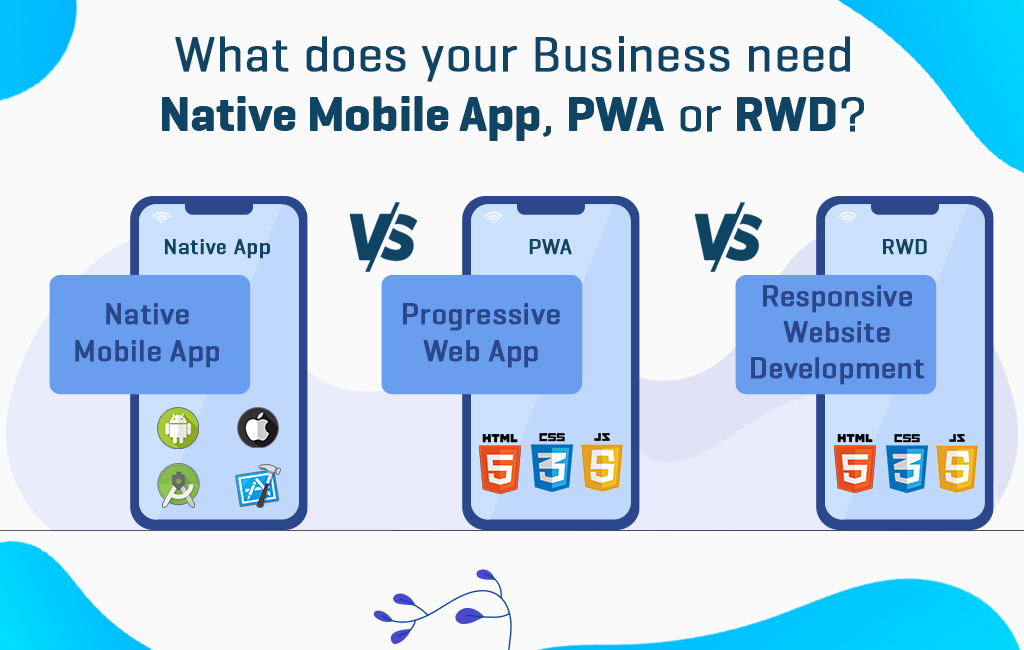In this modern world, people are habituated to use more and more digitalized devices like mobiles to get more and more information. To gain competiveness for any business it necessary to have some digital presence otherwise competitors will overtake your business. For making direct bonding between your business and your customers, carefully devised digital strategy is essential. The digital strategy should include all channels like website, mobile app, social media, online marketplace and search engines.
During website or Mobile app development for any business goal such approaches like Native apps and web apps are usually considered. Proper selection of approach to develop digital solutions depends on factors like your requirements, financial stability, goals (long term or short term goals). Building and maintaining a native app is cumbersome and often quite expensive. Luckily, there are few options. This option combines the joys of a native app with the technology we use on the Responsive web development (RWD), Progressive web app (PWA), Native mobile app, etc.
Responsive website development vs. Progressive web App:
RWD uses media query or bootstrap framework to render web pages in order to adopt them to different screen resolutions of Tablet, PC or Mobiles. Since it works off browser its device OS independent. Responsive web development needs active internet connection.
PWA are the next version of responsive web apps. It looks very similar to mobile apps but in reality, it isn’t a mobile app. Conversely, PWAs run on any device type without any differentiation as it uses web technologies. Progressive web App is nothing but faster than responsive internet apps. PWA apps are exceptional to Responsive Web Apps as they provide multiple mobile-specific features like: GPS, camera support, push notifications, detector support and can work without internet. Let’s compare RWD and PWA on different parameters.
1) COST: This unquestionably makes PWAs the more expensive of the two options. It can be costly to maintain the web app in the long run as compared to a RWD.
2) PERFORMANCE: PWAs reside in website browsers, it has certain data and code preloaded / cached in browser. Since the data is loaded from browser rather through https request, PWA has better performance and offers greater flexibility to customer.
3) UTILIZATION OF DEVICES FEATURES: PWA enjoys better support when it comes device native features like GPS, Camera support as compared to RWD
4) OFFLINE FEATURE: PWA architecture provides fast, reliable performance to users even they are on a slow connection or offline. RWD do not support offline mode.
5) SECURITY: An RWD can be just as secured as a PWA, it’s not required of websites to use secure communication protocols. But for PWA-powered websites as Google – founder of PWA, requires that all communications between the server and the client in a PWA are to be encrypted through the use of HTTPS.
6) DEPLOYMENT AND DISTRIBUTION: PWA and RWD is easy to deploy on server and users can access it through URI on browser. Both of them do not need any special store submission or any extra efforts.
It seems responsive web development is good if you have limited budget and time but PWA is much better if you also offer app offline while keeping cost and time checked.
Native mobile apps vs. Progressive web App:
PWAs serve web pages in a users’ browser seamlessly so they can have a mobile app-like experience. PWAs have an app like UX, delivered through the web with advanced technologies to optimize the user experience. Native Mobile apps, on the other hand, are software programs developed specifically for smartphones or tablets. These mobile apps are developed separately for iOS and Android devices. Native apps use a wide range of functionality that varies from device to device. Users can download these mobile apps via device-specific app stores.
1) COST: Native apps require higher coding skill and more time in development and testing so the Cost of development of Native apps is much higher than PWA.
2) PERFORMANCE: native apps consume less phone battery than PWAs do. Since a PWA runs on a mobile browser, there is no direct control over battery consumption. It depends on the latency of that browser. The native app’s efficiency and power consumption are under the control of the operating system it is compatible with. So that users can manage how native apps consume battery in the setting of their mobile devices.
3) UTILIZATION OF DEVICES FEATURES: Native mobile apps are coded to run smoothly on mobile devices and enjoys full support of advance features such as GPS, Camera and accelerometer whereas PWA are written to run inside a web browser has limited support with devices sensors.
4) OFFLINE FEATURE: Both PWA and Native mobiles apps offers offline feature and that’s the key feature that developer prefers when it comes to offline app development.
5) SECURITY: PWA requires SSL layer for communication with server and for native apps that are no such requirements. However for PWA data is stored in browser which might pose security issue compared to native apps which stores data locally within the app.
6) DEPLOYMENT AND DISTRIBUTION: PWA is easy to deploy on server and users can access it through URI on browser. Whereas Native mobile apps requires additional step of relevant App store submission: Itunes store for iphone app and google playstore for android app.
In essence RWD VS PWA VS Native App, all are very proficient and impressive online platforms that have all the potential to elevate your business to unprecedented heights.
Selection of RWD, PWA or Native apps depends on requirement, timeframe and budget of your business. To know which one suits your business, you must consider the functional disparities between them.








